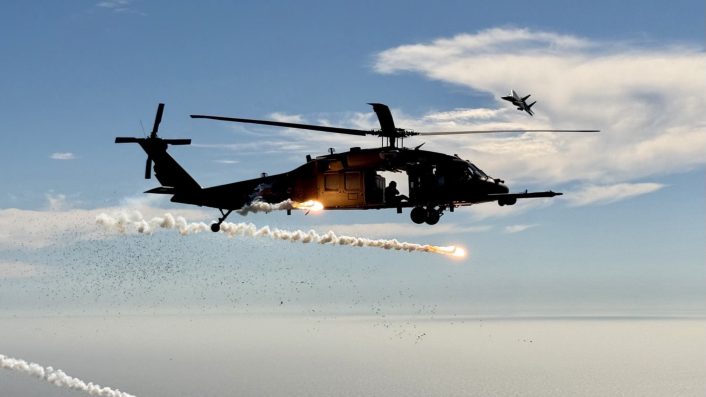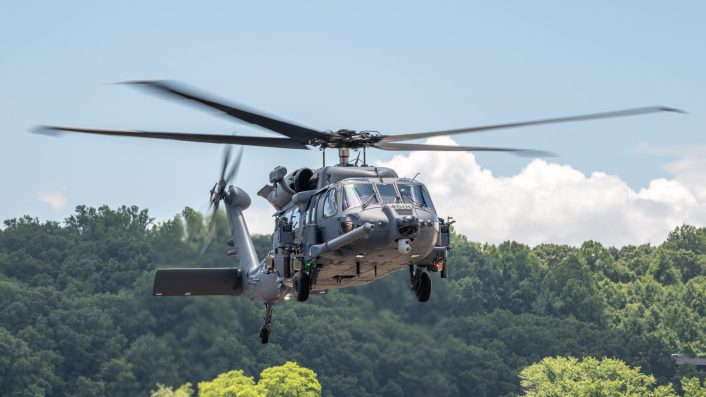In a first-of-its-kind test, the effectiveness of the HH-60’s countermeasures was evaluated in a maritime environment against modern aerial threats.
The U.S. Air National Guard and Air Force Reserve tested the survivability and countermeasure systems of an HH-60W Jolly Green II and an HH-60G Pave Hawk combat search and rescue helicopters against a simulated attack by an F-15D in a maritime setting. According to the announcement by Moffett ANGB (Air National Guard Base), California, on Aug. 25, 2025, the first-of-its-kind exercise evaluated the effectiveness of the countermeasures in helicopter and fighter aircraft engagements in maritime environment.
The Air National Guard Air Force Reserve Command Test Center (AATC) oversaw the trial, although the date is not clear. In fact, while the captions put the date of the test on Aug. 20, the VIRIN naming shows the images were taken on Aug. 25.
The tests involved an HH-60G Pave Hawk from the 129th Rescue Wing (129th RQW) at Moffett ANGB; an HH-60W Jolly Green II from the 305th Rescue Squadron at Davis-Monthan AFB, Arizona; and the F-15D Eagle from the 144th Fighter Wing (144th FW), from Fresno ANGB, California.
While the Naval Air Warfare Center at Naval Air Station (NAS) Point Mugu also provided “critical support,” the exercise “evaluated the effectiveness of countermeasures in a maritime environment,” where an F-15D Eagle from the 144th FW engaged with the HH-60G and the HH-60W. “The tests, simulating real-world scenarios, evaluated the helicopters’ defensive capabilities against modern aerial threats,” the release explained.
During a first-of-its-kind test, @TheCalGuard Airmen helped evaluate the defensive capabilities of HH-60G Pave Hawk and HH-60W Jolly Green II helicopters in real-world, over-water scenarios against modern aerial threats.
🔗https://t.co/zCkghHZaVL pic.twitter.com/SqVXLvX0r9
— National Guard (@USNationalGuard) August 27, 2025
The 129th RQW already started its transition from the HH-60G Pave Hawk to the HH-60W Jolly Green II, receiving the first two of six helicopters in February 2025. The remaining ones are to be delivered by the end of 2026. Based on the proven framework of the UH-60M Black Hawk, the HH-60W sports significant improvements over the HH-60G, focused on range, survivability, better engines, new rotor blades, avionics and armament.
The test
The images released on DVIDS show the Pave Hawk and Jolly Green over water, possibly off the Californian coast, releasing flares and chaff as the F-15D flew and maneuvered around it. The test may have involved the F-15D using its AN/APG-63 radar to track and lock the helicopters, and assessing the performance of their radar warning receivers and missile approach warning sensors.
These self-defensive suites are critical for exfiltrating and rescuing downed pilots in combat search and rescue in high-risk, air-defended and contested battlespaces, or even behind enemy lines. As the press release added, the results and data generated from the trial “will inform future training and equipment upgrades aimed at enhancing the survivability of rescue helicopters.”

The base further mentioned the participation of Las Vegas-based Modern Technology Solutions Inc. (MTSI) “providing electronic warfare analysis support” during the exercise. “Electronic countermeasures disrupt enemy sensors and weapons systems, crucial for aircraft protection,” the press release explained.
MTSI’s website says it provides “test and evaluation support in several domains, including electronic warfare,” as well as “full spectrum support of projects with core tasks including program management, test planning, test logistics, test conduct, data analysis, test reporting, and special studies and analysis at multiple locations.” The company has also provided ‘Operational Test’ and ‘Advanced EW Test’ capabilities to the 53rd Wing by supporting testing of the F-15EX, CCAs (Collaborative Combat Aircraft) and the Angry Kitten EA (Electronic Attack) pod.
The primary mission of the HH-60G Pave Hawk helicopter is to conduct day or night personnel recovery operations into hostile environments to recover isolated personnel during war. #ReadyAF #AimHigh pic.twitter.com/5Wya6KZ3ae
— U.S. Air Force (@usairforce) August 3, 2020
Among the standard self-defensive systems on the HH-60W Jolly Green II are theAN/APR-52 Radar Warning Receiver (RWR), AN/AAR-57 Common Missile Warning System (CMWS) and AN/ALE-47 Airborne Countermeasures Dispenser Systems. The test may have assessed their sensitivity, response time to radar and missile targeting at various ranges and modes – active, passive or Track While Scan (TWS).
ANGB personnel would have also firmed up tactics and procedures in such situations, incorporating them into future training curriculum.

‘First-of-its-kind test’
AATC’s HH-60 Division deputy director Lt. Col. Don Smith said the HH-60W Jolly Green II “has never undergone this type of evaluation.” He further added that “this test data will help us determine how effective U.S. countermeasures are against fighter aircraft over water.”
The reference is to how humid and saline environments on the high seas might affect the performance of the self-protection suites, since that would be the predominant terrain in a high-end war with China in the western Pacific.
The press release added that the test is significant for the Air National Guard, since it “faces unique training limitations.” Specifically, U.S. Air Force Lt. Col. Terry Parham, AATC HH-60 Division director, explained that “Guard units execute the same critical missions as active duty but often have fewer specialized training opportunities.”
Saying goodbye to a legend!
The 33rd Rescue Squadron honors the HH-60G Pave Hawk with a formation flight over Okinawa, marking its legacy since the early 90s.
As they transition to the HH-60W model, they’re gearing up for even more advanced combat and rescue ops. 🚁 pic.twitter.com/BWMjLV7XdZ
— Department of Defense 🇺🇸 (@DeptofDefense) May 4, 2024
The press release revealed the participation of the Air Force Reserve’s 305th and 943rd Maintenance Squadrons, which are both part of the 943rd Rescue Group at Davis-Monthan AFB, demonstrating “inter-unit and inter-service cooperation.” Additionally, “reservists from the 943rd overcame logistical challenges in preparing equipment for the test, highlighting their dedication.”
HH-60W Jolly Green milestones
An official fact sheet says the HH-60W Jolly Green II has other modifications including cabin and cockpit armor; externally mounted 7.62 mm or .50 heavy machine gun; Link 16 tactical data link; Situational Awareness Data Link; integrated cockpit and cabin displays; advanced communications; Automatic Dependent Surveillance-Broadcast; tactical moving map displays; upturned IR-masking exhausts; and efficient wide-chord rotor blades.
Ready to rescue! ⛑️ 🚁
A U.S. Air Force pararescueman from the 563rd Rescue Group participated in search-and-rescue training from an HH-60W Jolly Green II helicopter in support of exercise #REFORPAC 2025.#DLE2025 #563RG #IndoPacific pic.twitter.com/hq2McI8snQ
— PACAF (@PACAF) August 1, 2025
In the latest test, neither the HH-60G Pave Hawk nor the HH-60W Jolly Green II were armed. Early in August however, the Jolly Vihar 25 exercise in western Hungary saw HH-60Ws from the 56th Rescue Squadron from Aviano Air Base, in Italy, participating in live-fire drills with the weapons. The 56th RS received its first new HH-60W in Dec. 13, 2024. Aviano also retired its final five legacy HH-60G Pave Hawks the same year.
Prior to that, late in December 2022, the USAF revealed the HH-60W’s first real world CASEVAC operation in the Horn of Africa (HOA), where it saved the lives of two members of a “partner” force. The unspecified number of HH-60W helicopters from the 449th Air Expeditionary Group’s PRTF (Personnel Recovery Task Force) and an HC-130J Combat King II from the 347th Rescue Group were activated in the “pre-dawn hours” and following the “quick […] initial pickup of the injured [was] in and out of the area without incident.”
Airmen flying a HH-60W Jolly Green II rescued four injured civilians and one critically injured during search and rescue efforts in North Carolina.
Click to read this story from the @usairforce: 🔗 https://t.co/fi1QhuUYz3 pic.twitter.com/FkAC3mI3Ve
— Sikorsky (@Sikorsky) October 11, 2024
The first units to receive and field the new aircraft were the 41st Rescue Squadron, Moody AFB, Georgia and the 512th Rescue Squadron, Kirtland AFB, New Mexico. Then on Sep. 7, 2022, Moody AFB was the first across the USAF to deploy the new Jolly Green II for its first rescue mission by the 38th and 41st Rescue Squadrons.









